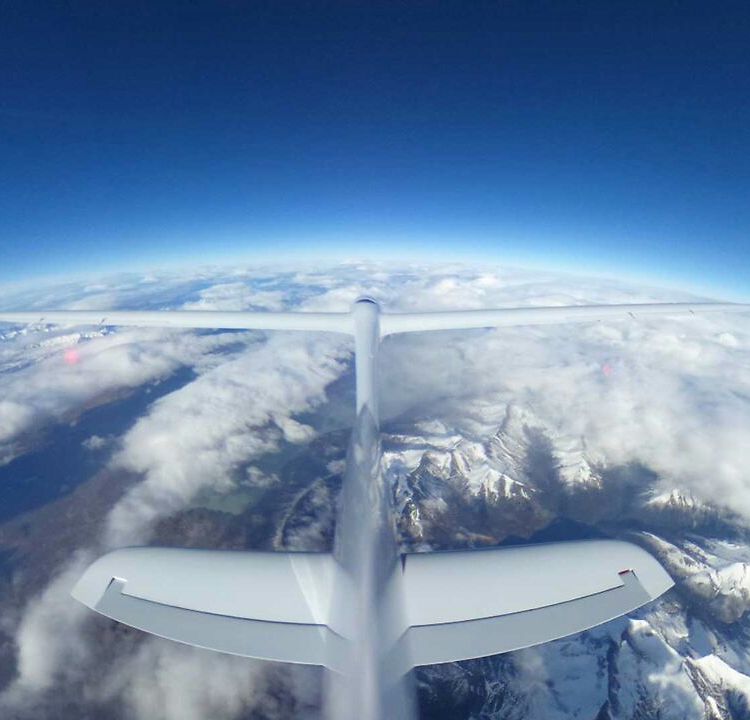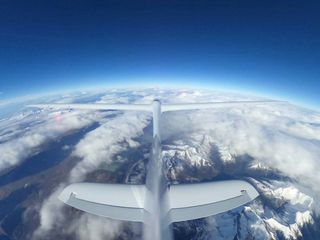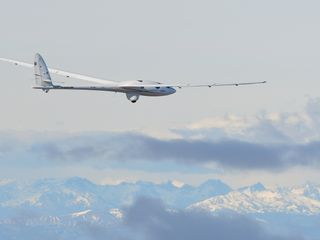El Calafate, Argentina, August 2, 2017 – Airbus Perlan Mission II, an initiative to fly a glider without an engine to the edge of space to collect ground-breaking insights on climate change, weather and high-altitude flight, this week reached a new high altitude in its second season of flight testing in El Calafate, Argentina. Pilots Jim Payne, Morgan Sandercock, Tim Gardner and Miguel Iturmendi have soared the pressurized Perlan 2 glider in a series of flights reaching a maximum altitude to date of 32,500 feet.
El Calafate, in the Patagonian region of Argentina, is in one of a few places on earth where a combination of mountain winds and the polar vortex create the world’s highest “stratospheric mountain waves” – rising air currents that Perlan pilots believe can eventually carry their experimental aircraft to the edge of space.
Over the next two months, the all-volunteer exploration team sponsored by Airbus will seek for the rare waves in an attempt to break the world gliding altitude record of 50,727 feet, set by Einar Enevoldsen and Steve Fossett in Perlan 1 in 2006. Along the way, the aircraft will continue to collect scientific data on the atmosphere made possible by the Perlan 2 aircraft’s unique attributes.
“Just last month the world witnessed another reminder of the importance of understanding climate change, with the fracture from the Antarctic ice shelf of an iceberg the size of the state of Delaware,” said Perlan Project CEO Ed Warnock. “Airbus Perlan Mission II will allow us to study a range of atmospheric phenomenon that ultimately will give us more accurate models of our upper atmosphere and the climatic changes that matter to every world citizen.”
The engineless design of the Perlan 2 sail plane enables it to collect uncontaminated air samples from a range of altitudes. Unlike a weather balloon, it can be steered, can stay in one area, and can take off and land in the same location.
Besides studying factors influencing climate change, Airbus Perlan Mission II will also provide insights into high altitude turbulence and radiation effects on pilots and aircraft.
“As demand for air travel rises, and we are faced with questions about how to safely and more efficiently transport a growing population, the insights that Airbus Perlan Mission II will be collecting are invaluable,” said Allan McArtor, Chairman of Airbus Americas. “Perlan’s discoveries will help us shape the future of aerospace with innovations related to design and engineering, more efficient air travel and even aviation science related to travel on Mars.”
Tune in to live flights of the Perlan 2 this summer on the Airbus Perlan Mission II Virtual Cockpit at http://bit.ly/VirtualPerlan2. Stay updated on flight schedules by following The Perlan Project on Twitter @PerlanProject and on Facebook at www.facebook.com/perlanproject.
For more information about Airbus Perlan Mission II, please go to www.perlanproject.org.
Press Kit with images, infographic, fact sheet, and video is available at: http://bit.ly/perlanpress.
About Airbus
Airbus is a global leader in aeronautics, space and related services. In 2016, it generated revenues of € 67 billion and employed a workforce of around 134,000. Airbus offers the most comprehensive range of passenger airliners from 100 to more than 600 seats. Airbus is also a European leader providing tanker, combat, transport and mission aircraft, as well as Europe’s number one space enterprise and the world’s second largest space business. In helicopters, Airbus provides the most efficient civil and military rotorcraft solutions worldwide.
About Airbus Perlan Mission II
Airbus Perlan Mission II is an initiative to fly an engineless glider to the edge of space, higher than any other winged aircraft has operated in level, controlled flight, to open up a world of new discoveries related to high-altitude flight, weather and climate change. This historic endeavor is the culmination of decades of research and engineering innovation, and the work of a tireless international team of aviators and scientists who volunteer their time and expertise for the non-profit Perlan Project. The project is supported by Airbus and a group of other sponsors that includes Weather Extreme Ltd., United Technologies and BRS Aerospace.
Perlan’s other sponsors:
United Technologies
Weather Extreme Ltd.
BRS Aerospace
Equipment, service and institutional donors:
Aero Club Lago Argentino
AGM Container Controls
ANAC
Automated Metal Products
Argentina Air Force Directorate-General of Research and Development
Biomarine Rebreathers
Bonehead Composites
Cobra Trailer
Community Foundation of Western Nevada
Clouddancers
DeLorme inReach
Dragonfly Energy
EANA
Epic Aircraft
Garmin
Intel
Iridium Communications Inc.
Kiloyankeepapa
Laviasa
Leading Edge Jet Center
LX Nav
Miller Nash Graham & Dunn
MH Aviation Oxygen Systems
Omni
Pro-Tint
RDD
Sandia Aerospace
Silicon Valley Community Foundation
SIMCOM
SoaringNV
Soaring Society of America
Sports Aviation Foundation
Trig Avionics
University of Washington Applied Physics Laboratory
Whelen Engineering
Your media contacts
Contact us
Liana Sucar-Hamel
AIRBUS | United States


